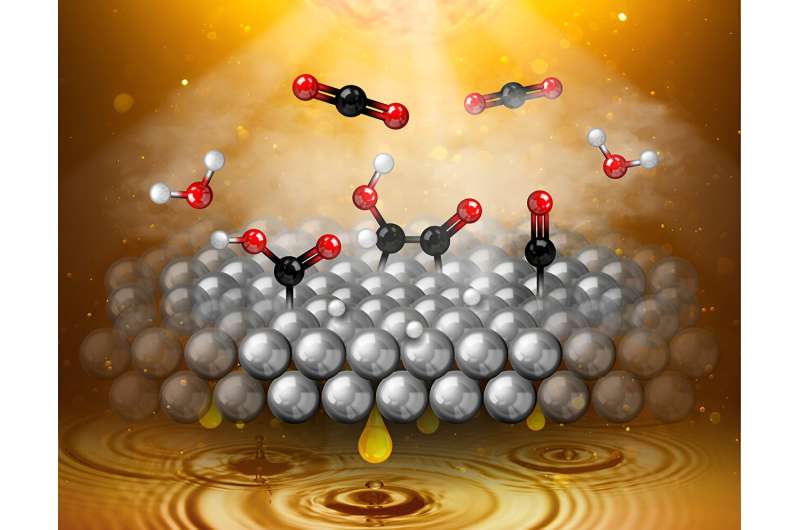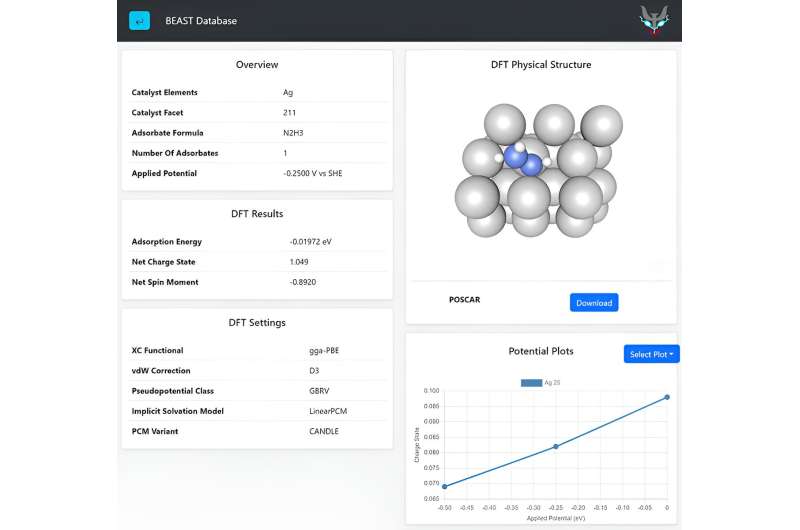This article has been reviewed according to Science X's editorial process and policies. Editors have highlighted the following attributes while ensuring the content's credibility:
fact-checked
trusted source
proofread
New database aims to accelerate electrocatalyst development through atomic-scale insights

The quest for more productive catalysts for the creation of sustainable fuels and commodity chemicals via electrochemical reactions just became easier.
Powered by renewable electricity, electrocatalysts producing fuels and chemicals from water, carbon dioxide, or nitrogen have the potential to decarbonize the heavy transport and chemical industries. This decarbonization can be achieved by direct replacement of fossil fuels or lower-energy production of fuels and chemicals.
A new open-source electrocatalysis database, developed by the National Renewable Energy Laboratory (NREL) and its partners, provides researchers with a comprehensive view of electrochemical energy conversion. The extensive data enable insight into the fundamental factors that govern changes in catalyst performance and can expedite the design of electrocatalysts.
The new database was developed by the Beyond-Density Functional Theory Electrochemistry with Accelerated and Solvated Techniques (BEAST) team. The BEAST consortium, led by Ravishankar Sundararaman from the Rensselaer Polytechnic Institute, includes collaborators at NREL, Lawrence Berkeley National Laboratory, the University of Colorado Boulder, and the University of South Carolina.
A database for atomistic insights into electrochemistry
The BEAST database, or BEAST DB, allows experimental and theoretical electrochemists to explore atomic-scale catalytic reactions and view numerous properties on catalyst performance.
Examples of critical electrochemical reactions include converting water, carbon dioxide, or nitrogen to hydrogen, formic acid or other reduced carbon-based molecules, and ammonia, respectively, using electrocatalysts. Understanding the fundamental properties during electrocatalysis can lead to advancements in catalyst efficiency and productivity.
Derek Vigil-Fowler, the computational science researcher at NREL who conceptualized BEAST DB, believes that this data can enable a holistic understanding of these catalysts.
"Having standardized baseline results for the most widely studied electrocatalytic reactions in one place allows researchers to have a one-stop shop for acquiring a basic understanding of how their catalyst works at the atomic scale.
"They can visualize molecular adsorption on the surface and the charge transfer that drives electrocatalytic reactions and understand how that varies across catalysts and applied potential ranges. Others can build upon these calculations with new calculations and experiments and make advancements in the field," Vigil-Fowler said.
"The ultimate goal of BEAST DB is to make it easier to explore catalyst performance and develop new catalysts for different chemical reactions."
The diversity of conditions in published electrochemical experiments and theoretical calculations hinders a complete understanding of electrochemical systems. While density functional theory (DFT) can predict catalytic behavior, DFT methods inadequately represent the length and time scales in electrochemical reactions, especially at the dynamic electrode-electrolyte interface.
BEAST DB employs a systematic framework that overcomes DFT deficiencies and accurately models electrochemical systems, providing clear baselines for electrocatalyst performance and serving as a building block for further theoretical developments.
The database also uses uniform calculation settings, a crucial piece missing in the literature that will allow for easier comparison of catalytic activity and productivity across different electrocatalysts and under different conditions.

A detailed window into thousands of catalytic reactions
BEAST DB utilizes grand-canonical methods to model ab initio electrochemical solvation for electrolytes to generate performance data on more than 24,000 molecule-catalyst combinations, where researchers can explore the reaction energetics for different transformations on catalytic surfaces.
The database includes promising electrocatalysts for the carbon dioxide reduction reaction, oxygen reduction reaction, oxygen evolution reaction, nitrogen reduction reaction, and hydrogen evolution reaction. Users can sort and view by calculation types, including absorbate formula, catalyst composition, and catalyst facet.
Each reaction type links to a dedicated calculation page that provides more reaction data, including an interactive 3D plot of the calculation to visualize the physical structure and plots of the charge on the molecule and the catalyst active site.
Users can also download a POSCAR structure file for ease of use with other visualization and analysis tools standard to the materials and catalysis communities.
The BEAST team provides conversion scripts to the format needed for the software packages powering BEAST DB—JDFTx and BerkeleyGW—to reproduce the database results and perform additional calculations to provide further scientific insight.
Each of the above database properties can help researchers rationalize why catalysts are as effective as they are during electrocatalysis, while the data itself and the ability to build on it enable the creation of machine learning models that help inform the construction of new catalysts.
Accelerating a decarbonized future with electrocatalysis
Jacob Clary, an applied researcher at NREL working on the BEAST team who was instrumental in developing BEAST DB, is hopeful that the database will become an important tool to the electrocatalysis research community.
"I think the BEAST consortium overall is exciting because we're developing state-of-the-art tools to model electrocatalytic systems at higher fidelity and lower computational cost than existing approaches," Clary said.
Taylor Aubry, a computational science researcher at NREL and contributor of data to BEAST DB, is also looking forward to the value the database will bring.
"I anticipate that studies enabled by BEAST DB will provide invaluable insights into the myriad processes necessary for realizing a sustainable, decarbonized future, wherein electrochemical catalysis assumes a central role," Aubry said.
Bill Tumas, associate laboratory director of NREL's Materials, Chemical, and Computational Science directorate, said, "The versatility and amount of data in BEAST DB will go a long way toward helping researchers understand, predict, and control the design of electrocatalysts.
"Discovery of innovative electrocatalysts that enable the production of sustainable fuels and commodity chemicals has just become easier with this valuable tool."
The BEAST team will collaborate with electrocatalysis researchers on their next round of data generation and encourages input and collaborations from users of the database. The next version will include more complex representations of catalyst surfaces and reactions, e.g., defects, surface coverage, and lattice oxygen mechanisms.
Provided by National Renewable Energy Laboratory



















